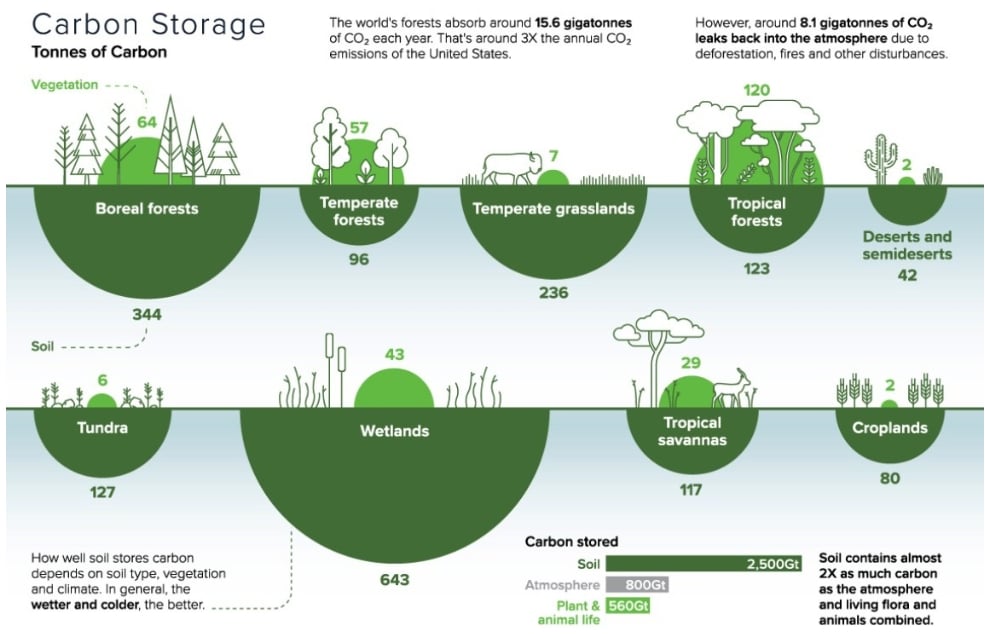November 23, 2025 | 23:43 GMT +7
November 23, 2025 | 23:43 GMT +7
Hotline: 0913.378.918
November 23, 2025 | 23:43 GMT +7
Hotline: 0913.378.918

Soil is an untapped storage solution. Image: Visual Capitalist
Brown stuff that sticks to your shoes might seem an unlikely hero in the story of our fight against the climate crisis. But mud and soil are currently being tipped for starring roles as scientists seek ways to capture more carbon.
Simple techniques to improve soil quality could help us reach our climate targets, scientists say.
Crop rotation, planting cover crops and using direct drilling could store around 31 gigatonnes of carbon dioxide annually, according to land management company, Downforce Technologies.
And that would make a sizable impact since it is close to the 32 gigatonnes gap that exists between planned emissions reduction globally per year, and the amount of carbon that must be cut by 2030 to stay within 1.5C global heating, Downforce’s Chief Scientist, Jacqueline McGlade told The Guardian.
The calculations underscore the vital part soil plays. Yet 33% of soil is already degraded around the world, reports the UN. More carbon resides in soil than in the atmosphere and all plant life put together, research shows.
A recent study has found that more than half of Earth's species live in the soil, with the study finding it was the world's most biodiverse habitat.
The importance of healthy soil around the world was the focus of a panel chaired by Tania Strauss, the World Economic Forum’s Head of Food and Water, at the Forum’s 14th Annual Meeting of the New Champions (AMNC) in Tianjin, People’s Republic of China.
Science, technology and nature can come together to help restore soils, the panellists said.
“Soil is like a bank account,” said Ole Kristian Sivertsen, Chief Executive Officer at Desert Control, an innovative Uplink company that harnesses AgTech to combat soil degradation.
Restoring soils that are currently degraded has the potential to store much more carbon, Sivertsen said, but innovation is vital.
The Forum’s 100 Million Farmers programme is a multi-stakeholder platform promoting action on farms to underpin the transition to net-zero food systems by 2030.
Access to technology and smart farming tools forms a large plank of the strategy for smallholder farms, Doris Yu, Senior Vice-President at Yara International, told AMNC.
Better soil has huge potential to help mitigate the climate crisis, and it’s currently untapped, said Fan Shenggen, Chair Professor, China Agricultural University, at the same event.
“Without soil, there would be no human beings,” Shenggen said. “That’s the importance of soil.”
(The Guardian)

(VAN) In Brazil, FAO unveiled a series of reports and initiatives showing how sustainable agrifood systems are a solution to the climate crisis.

(VAN) With names like neodymium and dysprosium, rare-earth elements sound exotic — and their perceived scarcity has only added to the mystique.

(VAN) In a new study published in Trends in Biotechnology, researchers used a gene-editing technology called CRISPR to increase a fungus's production efficiency and cut its production-related environmental impact by as much as 61%- all without adding any foreign DNA.

(VAN) A top official in Beijing’s Cop delegation says China is committed to clean energy – but US’s absence is a problem.

(VAN) The Bangsamoro region’s inflation rate rose slightly to –1.3 percent in October 2025 from –1.5 percent in September, the Philippine Statistics Authority (PSA-BARMM) reported.

(VAN) FAO-led report says protecting and restoring forests is crucial to boosting climate-resilient agriculture, rural livelihoods and global food and water security.

(VAN) Flagship partnership secures additional GBP 16.9 million to strengthen forest monitoring, transparency and country support to 2030.